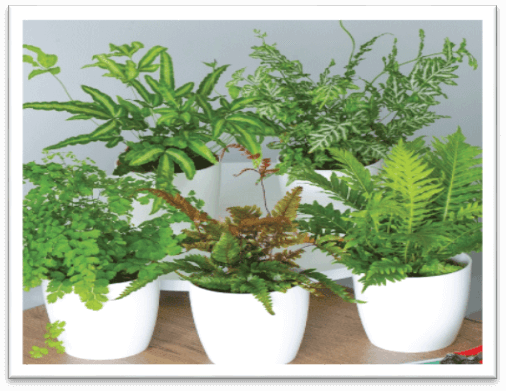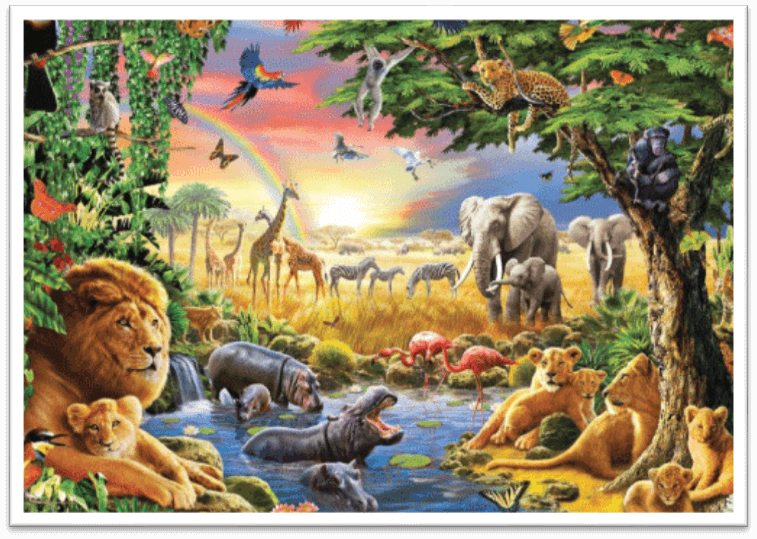How Are Fungi Different From Animals And Plants
next → ← prev
Difference betwixt Plants and Animals
The earth is home to various plants and animals, which are divided into several categories. We know that in that location are several dissimilarities between plants and animals, but we may not know all of them. When we say the plant, we retrieve of green things which may prepare their food. Similarly, when you hear the discussion 'animal', y'all may think of organisms with a well-developed trunk with an accurate organ system. Thus, they're piece of cake to distinguish.
Plants
"A plant is additionally a living being that builds up inside the world and generally has body parts similar stem, leaves, and roots, etc. When anybody sows land with a specific kind of plant or harvest, they identify plants, seeds, or little trees into the soil.

Plants are generally multicellular organisms, largely photosynthetic eukaryotes of the authorisation Plantae. Previously, plants included all living things that weren't animals, and each one alga and fungi were considered plants. Yet, all existing explanations of Plantae keep out the fungi and a few algae, farther because of the prokaryotes (the archaea and bacteria). And then, by a definition, we tin can say that plants form the clade Viridiplantae (name in the Latin linguistic communication for "light-green plants"). This establish group contains the blossoming plants, conifers, and other gymnosperms, ferns and allies, hornworts, liverworts, mosses, and dark-green algae, etc. But they exercise not allow the cherry-red and the brown algae along with them.
Light-green plants acquire much of their energy from sunlight past photosynthesis with main chloroplasts resulting from endosymbiosis with cyanobacteria. Their chloroplasts hold chlorophylls a and b, which provide them with their green color. Some plants are parasitic or mycotrophic and are non capable of producing an average quantity of chlorophyll or photosynthesize like other plants only notwithstanding have flowers, fruits, and seeds. Plants are distinguished past reproduction and fluctuation of generations, even though agamogenesis is additionally expected.
The expression "found" unremarkably involves possessing the specific traits such as multicellularity, cell walls, cellulose, and therefore the flexibility to perform photosynthesis past principal chloroplasts.
When the name Plantae or plant is useful to a chosen group of organisms or taxon, it is compulsory that they anyhow belong from ane of these three groups. If we conform them in ascending order, the main three groups are:
- Land plants also called Embryophyta.
- Green plants moreover noted as Viridiplantae, Viridiphyta, Chlorobionta or Chloroplastida
- Archaeplastida, every bit well named as Plastida or Primoplantae.
A different method of gazing at the relations among the various groups of plants is past a cladogram, which demonstrates their evolutionary relationships.
Animals
Animals are multicellular eukaryotic creatures that belong to the biological kingdom Animalia. With few anomalies, animals swallow organic cloth, inhale oxygen, capable of being in motion, reproduce sexually, and develop from an empty sphere of cells, the blastula, during embryonic progress.

More one.5 million breathing animal classes are antiseptic, out of which around 1 million are insects. Nonetheless, information technology has been predicted that there are more than seven one thousand thousand animal varieties in entire. The Animals constitute nearby u.s.a. are usually having a height from 8.five micrometers (0.00033 in) to 33.half-dozen meters (110 ft). They need complex interactions with one some other and their environments, forming complicated food webs. The scientific learning of animals is understood every bit zoology.
The expression "animal" is taken past the Latin language word animalis, which are able to breathe, having the spirit or living animate being. The biological description consists of all associates of the authority Animalia. In everyday tradition, the word animal is typically used to submit but to nonhuman animals.
Most existing animal class is in Bilateria, a clade whose members accept a symmetrical body programme. Animals have some specific characteristics that make them dissimilar from other living creatures. Animals are eukaryotic and multicellular, but they are not like plants and algae, which produce their own nutrients, animals are heterotrophic, nourishing on organic material and assimilate it internally. With only some exceptions, animals exhale aerobically. All animals are motile (capable to shift their bodies impulsively) and can move themselves. Still, several animals, similar sponges, corals, mussels, and barnacles, may plow into sessile. The blastula can be a stage in embryonic growth that's sectional to most animals.
Humans also use some animals for their needs, like foodstuff (meat, milk, and eggs), resource (like leather and wool), or for keeping them as pets and functioning animals for ship. Dogs help them hunt, while many earthly and marine animals were required for games. All animals are fabricated up of cells. During their growth, the animal cells differentiate and form different internal organs and body parts of an animal.
Reproduction in Animals
Well-nigh all animals choose several methods of sexual reproduction. They brand haploid gametes by meiosis; the slighter, motile gametes are spermatozoa, and the superior, not-motile gametes are ova. These fuses create zygotes, which enlarge through mitosis into an empty sphere, called a blastula. In sponges, blastula larvae swim to a fresh place, connect to the marine, and expand into a fresh sponge. In the bulk of dissimilar groups, the blastula undergoes more complex reorganization. Information technology primarily invaginates to create a gastrula with a digestive hollow and two divided germ coatings, outside ectoderm and anterior endoderm. In the majority of cases, a third germ coating, the mesoderm, too develops among them. These germ layers then distinguish between forming tissues and organs.
A frequent example of mating with a close family unit member in the elapsing of sexual reproduction usually leads to inbreeding melancholy within a population due to the increased prevalence of damaging recessive character. Yet, animals accept developed many mechanisms for keeping abroad from shut inbreeding.
Some animals use asexual reproduction, which mainly results in a genetic replica of the parent. This tin be done through fragmentation, budding such every bit in Hydra and farther cnidarians, or parthenogenesis, in which fertile eggs are created without mating, for instance, in aphids.
Animals can be carnivores, herbivores, omnivores, and parasites based on how they get or consume the organic substance. These connections between animals create circuitous food chains. In carnivorous or omnivorous types, predation occurs in which an animal feeds on a further living being, which is known as its prey.
History most the categorization of plants and animals
All living things were normally located into one of the 2 categories, plants and animals. This categorization started with Aristotle (384 BC – 322 BC), who prepared the distinction amid plants, which usually don't shift, and animals, which frequently can movement to take hold of their nutrient. After a while, when Linnaeus (1707–1778) formed the foundation of the fashionable scheme of scientific categorization, these two groups became the kingdoms Vegetabilia (later Metaphyta or Plantae) and Animalia (also called Metazoa). Ever since then, information technology became obvious that the dominions are formerly defined into some unrelated groups. Then the fungi and some further groups of algae were detached to new kingdoms. Anyways, these organisms are notwithstanding considered plants, mainly in the appropriate context.
Divergence between plants and animals
Plants can prepare their own food with the support of sunlight, h2o, and air, and with the help of the dark-green pigment recognized equally chlorophyll which originates in all the light-green plants. On the other side, animals are identified for their well-maintained body and organ system such equally nervous, reproductive, digestive, respiratory, etc. Animals are as well measured to be massively vulnerable or sensitive to whatever abnormal condition. Major differences between the plants and the animals are given in the below-given table;
| Plant | Animal |
|---|---|
| Plants are green-colored living beings that are able to make their food with the assistance of photosynthesis. | Living organisms that feed on organic substances and consist of an organ system are known every bit animals. |
| Plants can't be in motion as they are deep-rooted in the land. In that location are few exceptions similar Volvox and Chlamydomonas. | The animals may shift freely from one identify to another. Exceptions are Sponges and Corals. |
| Plants take carbon dioxide and release oxygen. | Animals inhale oxygen and exhale carbon dioxide. |
| They don't have whatever digestion system. | They take a proper digestive system. |
| Plants perform asexual reproduction mostly. | Animals perform sexual reproduction mainly. |
| The plants illustrate response with the help of bear on and light. | The suitable nervous organisation permits reaction speedily. |
| Plants perform respiration through stomata. | Fauna performs respiration through gills, lungs, pare, and other respiratory organs. |
| The food is stored in the form of starch. | The food is stored in the form of glucose. |
| A plant has a cell wall, chloroplast, plasmodesmata, plastids, and unlike organelles. | Beast cells lack cell walls but incorporate different organelles such every bit tight junctions and cilia. |
| In the plants, the growth is washed past the meristematic system located at the tip of roots and stems. | Organs and organ systems help in enlargements in the animals. |
| They are less sensitive. | They are more sensitive in comparison to plants. |
| Few examples of plants are Cactus, moss, conifers, flowering plants, vascular plants, etc. | Few examples of animals are snakes, birds, fishes, cats, dogs, etc. |
Adjacent Topic Difference between
← prev next →
Source: https://www.javatpoint.com/plants-vs-animals
Posted by: adornofreeack.blogspot.com

0 Response to "How Are Fungi Different From Animals And Plants"
Post a Comment